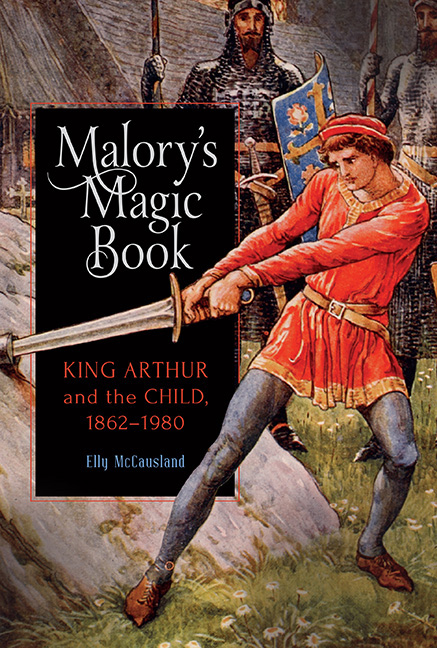Book contents
- Frontmatter
- Dedication
- Contents
- List of illustrations
- Acknowledgements
- A note on names
- Introduction
- 1 ‘Ever fresh and fascinating to the boy and girl of today’: the timeless child and the childish medieval in nineteenth-century Arthuriana
- 2 Risk and revenue: adventurous Arthurian masculinities in the work of Howard Pyle and Henry Gilbert
- 3 The ill-made adult and the mother's curse: psychoanalysing the Arthurian child in T. H. White's The Once and Future King
- 4 ‘Monty Python was not that far away’: the instability of 1950s Arthuriana for children
- 5 ‘For a little while a magician’: potent childish fantasies in John Steinbeck's Acts of King Arthur and his Noble Knights
- Conclusion: At the crossing-places
- Bibliography
- Index
- Arthurian Studies
Conclusion: At the crossing-places
Published online by Cambridge University Press: 04 April 2019
- Frontmatter
- Dedication
- Contents
- List of illustrations
- Acknowledgements
- A note on names
- Introduction
- 1 ‘Ever fresh and fascinating to the boy and girl of today’: the timeless child and the childish medieval in nineteenth-century Arthuriana
- 2 Risk and revenue: adventurous Arthurian masculinities in the work of Howard Pyle and Henry Gilbert
- 3 The ill-made adult and the mother's curse: psychoanalysing the Arthurian child in T. H. White's The Once and Future King
- 4 ‘Monty Python was not that far away’: the instability of 1950s Arthuriana for children
- 5 ‘For a little while a magician’: potent childish fantasies in John Steinbeck's Acts of King Arthur and his Noble Knights
- Conclusion: At the crossing-places
- Bibliography
- Index
- Arthurian Studies
Summary
The story of King Arthur will never die while there are English men to study and English boys to devour its tales of adventure and daring and magic and conquest.
So wrote J. T. Knowles, presciently, in his preface to The Story of King Arthur and his Knights of the Round Table (1862), the first adaptation of the Morte Darthur for children. This book has traced the fulfilment of Knowles's prediction, finding scholars, boys, magic, daring, adventure and ideas of the ‘English’ at the heart of child-focused Malory adaptation since 1862, partly responsible for its origins and influencing its continuation through to the present day. The precise relationship between these aspects has shifted over time. The earliest adaptations of the Morte for children identified its apparent affinity with both boys and adventure, as well as its complicated relationship with ideas of Englishness and heritage. They set the stage for subsequent child-focused Arthuriana in their gendering of the legend and their emphasis upon the medieval as a locus of daring adventure that could also have educational and moral applications. Later adaptations by Howard Pyle and Henry Gilbert were similarly concerned with extracting moral messages from Malory's tale, but instead used the text's ample adventures to contemplate the relevance of chivalry and heroism for boys in an increasingly mercantile twentieth-century society. The adaptations following the First and Second World Wars relinquished both this focus on physical adventure, and on boys. The childness of child-focused Arthuriana became increasingly gender-neutral as the twentieth century progressed, and adventures of the body gradually gave way to the mental adventures of the childhood psyche and the nostalgic adult, enshrined most extensively in T. H. White's idiosyncratic The Once and Future King, which symbolically placed the entire Arthurian legacy in the hands of an imaginative, creative child: the young Thomas Malory.
Influenced by the psychological interpretations of his predecessors but ultimately driven by his own childhood relationship with Malory's ‘magic book’, John Steinbeck placed magic at the forefront of Malory's tale. In doing so, he crafted a new type of Arthurian child. No longer innocent or ignorant, an object of didacticism or a fragile, traumatised being, the child of Steinbeck's Acts is a powerful, resilient figure – albeit an ultimately undeveloped one – used to centre its author's enquiries into the nature of childhood, memory, creativity and fantasy.
- Type
- Chapter
- Information
- Malory's Magic BookKing Arthur and the Child, 1862–1980, pp. 177 - 192Publisher: Boydell & BrewerPrint publication year: 2019

